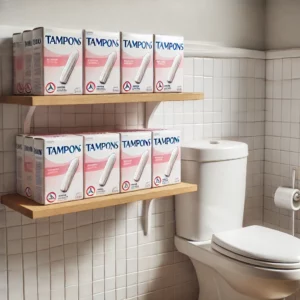Groundbreaking Study Reveals Unexpected Findings
A recent study published in the scientific journal Environment International has uncovered the presence of toxic metals, including arsenic and lead, in over a dozen popular brands of tampons. This revelation has sparked concerns about the safety of a product used by millions of menstruating individuals in the United States, with an estimated 52% to 86% of menstruating people using tampons regularly.
5 Key Points
- Study finds toxic metals in popular tampon brands
- Arsenic, lead, and cadmium are among the metals detected
- Organic tampons are not exempt from metal contamination
- FDA classifies tampons as medical devices but doesn’t require chemical testing
- Experts call for more research and stronger regulations
Understanding the Study’s Findings
Researchers from UC Berkeley, Columbia University, and Michigan State University examined 30 tampons from 14 brands and 18 product lines. The study, led by Jenni Shearston, a postdoctoral scholar at UC Berkeley School of Public Health, is believed to be the first to measure metals in tampons precisely.
The team detected measurable concentrations of all 16 metals they sought, with elevated mean concentrations of toxic metals such as lead, arsenic, and cadmium. Interestingly, the study found that lead concentrations were higher in non-organic tampons, while arsenic levels were higher in organic tampons.
Methodology and Sample Selection
The researchers carefully selected their sample to represent a wide range of products:
- Tampons of various absorbencies were included
- Products were identified as “top sellers” by a major online retailer
- Purchases were made both online and in-store
- Samples were collected from New York City, London, and Athens
- The collection period spanned from September 2022 to March 2023
This diverse sampling approach aimed to provide a comprehensive overview of the market and account for potential regional variations.
Potential Sources of Metal Contamination
The study suggests several ways metals could enter tampons:
- Contamination of raw materials (cotton, rayon) during production
- Intentional addition during manufacturing for odor control
- Use as pigments or antibacterial agents
- Environmental contamination through water, air, or soil during the growth of cotton or the production of rayon
These findings highlight the need for closer scrutiny of the tampon production process and its potential impact on product safety. The variation in metal concentrations between organic and non-organic tampons also raises questions about different manufacturing processes and their effects on product composition.
Health Implications and Concerns
The adverse health effects of heavy metals are well-documented and wide-ranging, including:
- Damage to cardiovascular, nervous, and endocrine systems
- Liver, kidney, and brain damage
- Increased risk of dementia and cancer
- Harm to maternal health and fetal development
Dr. Nathaniel DeNicola, an OB-GYN who served as the environmental health expert for the American College of Obstetricians and Gynecologists, emphasizes that the crucial question is determining when the amount of metals becomes dangerous. He notes that some metals found in the tampons, such as copper, calcium, iron, and zinc, are considered safe and often recommended by doctors.
However, researchers caution that more studies are needed to determine how these metals might “leach out of tampons” and into users’ bodies. The study authors calculated that people who menstruate may use more than 7,400 tampons over their reproductive years, with each tampon staying in the vagina for several hours at a time, highlighting the potential for cumulative exposure.
Regulatory Landscape and Calls for Action
The Food and Drug Administration (FDA) classifies tampons as medical devices and regulates their safety in the United States. However, there is currently no requirement to test tampons for chemical contaminants. The FDA only recommends that tampons not contain pesticide residue or dioxin.
FDA spokesperson Amanda Hils told NPR that the agency is reviewing the research and plans to “evaluate the study closely and take any action warranted to safeguard the health of consumers who use these products.”
In light of these findings, researchers and experts are calling for:
- More comprehensive studies on the potential health impacts
- Stronger regulations for tampon manufacturing and testing
- Better labeling on tampons and other menstrual products
- Mandatory testing for heavy metals in tampons
Lead author Jenni Shearston expressed hope that “manufacturers are required to test their products for metals, especially for toxic metals,” and called for better labeling on tampons and other menstrual products.
Industry Response
The Center for Baby and Adult Hygiene Products (BAHP), an industry group, defended the safety of its member companies’ menstrual products in a 2022 statement. They acknowledged the presence of chemicals but stated, “If present, these are not intentionally added by the manufacturers.” The BAHP also claimed that some impurities are present in the environment or naturally present at much higher levels in common fruits and vegetables or made by the human body.
Consumer Response and Alternatives
For concerned consumers, experts suggest several strategies to reduce exposure to chemicals in tampons potentially:
- Choosing products with fewer and simpler ingredients
- Avoiding tampons with fragrances and colorants
- Considering alternatives like pads or menstrual cups
- Using apps to scan product barcodes and see what chemicals they contain
However, it’s important to note that the organic label does not guarantee the absence of heavy metals in tampons. Catherine Roberts, a health and science journalist at Consumer Reports, emphasizes that “organic label was not a guarantee that these products would not have heavy metals.”
Environmental Considerations
Beyond potential health concerns, the study also highlights environmental issues associated with tampon use. Dr. DeNicola notes that plastic from tampons is one of the most significant sources of waste worldwide, though some brands are more eco-friendly than others. This environmental impact has contributed to the increasing popularity of reusable alternatives like menstrual cups.
Looking Ahead: Balancing Concerns and Practicality
While this study raises important questions about tampon safety, experts emphasize that it doesn’t necessarily mean people should stop using tampons altogether. Dr. DeNicola stresses that the study is “more of a reality check for the consumers and the public at large, that most products you’re using do not go through rigorous testing for safety, and most products do have chemicals in there.”
As research continues and regulations evolve, consumers are encouraged to stay informed and make choices that best suit their needs and concerns. The study marks an essential first step in understanding the presence of toxic metals in tampons. Still, much more research is needed to fully understand the potential health implications and inform future regulatory decisions.
FAQ
Q. Do you qualify for a personal injury lawsuit?
A. To see if you qualify, click here.
Q. Are organic tampons safer than non-organic ones?
A. The study found that organic tampons are not exempt from metal contamination. Arsenic levels were higher in organic tampons, while lead levels were higher in non-organic ones.
Q. What are some alternatives to tampons?
A. Alternatives include pads, menstrual cups, and period underwear. These options may have different environmental impacts and potential chemical exposures.
Q. Does the FDA require testing for toxic metals in tampons?
A. the FDA does not require testing for chemical contaminants in tampons. The agency classifies tampons as medical devices but only recommends that they not contain pesticide residue or dioxin.
Q. How can consumers reduce their exposure to potentially harmful chemicals in tampons?
A. Experts suggest choosing products with fewer ingredients, avoiding fragrances and colorants, and considering alternatives like menstrual cups. However, it’s important to note that no option is guaranteed to be free from all contaminants.
Q. Are the levels of toxic metals found in tampons harmful?
A. More research is needed to determine how much these metals might leach into the body and their potential health impacts. The study is a first step in identifying the presence of these metals, but further studies are required to assess their health effects.
Citations:
Treisman, R. (2024, July 11). A study found toxic metals in popular tampon brands. Here’s what experts advise. NPR. https://www.npr.org/2024/07/11/nx-s1-5036484/tampons-heavy-metals-study
Shearston, J., et al. (2024). Measurement of metals in tampons: A preliminary study. Environment International.






